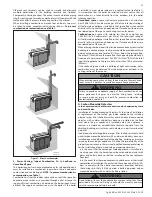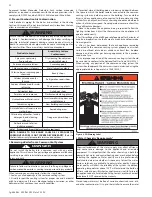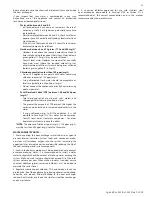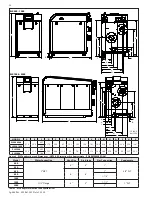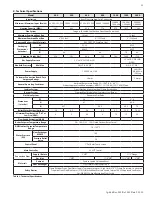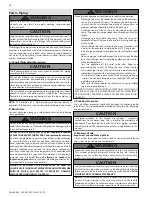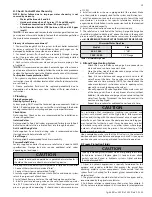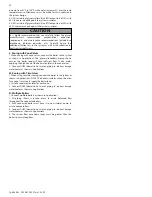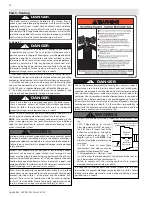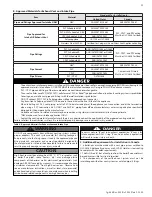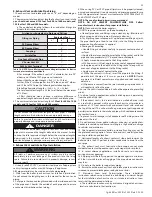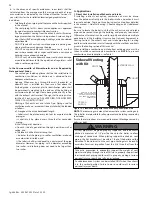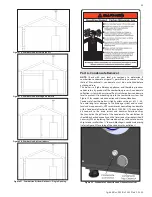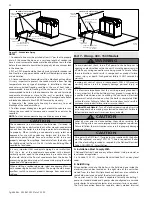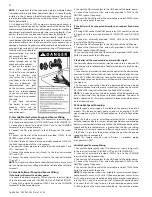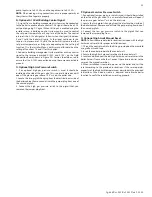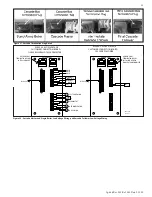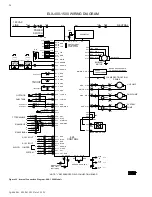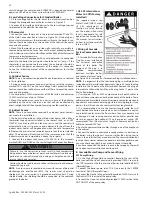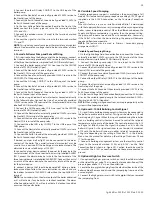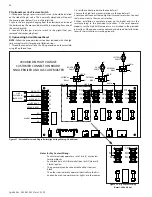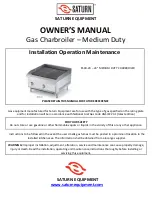
lp-666 Rev. 003 Rel. 001 Date 2.25.20
25
Friction Loss Equivalent in Piping and Fittings
Fittings or Piping
Equivalent Feet
4”
6”
8”
90 Degree Elbow
5’
45 Degree Elbow
3’
Coupling
0’
Air Inlet Tee
0’
One Foot of Straight Pipe
1’
V Series Vent Kit
1’
AL29 4c Vent Terminal
1’
Table 10 - NOTE: Consult Polypropylene venting instructions for friction
loss and pressure drop equivalents.
b. For example: If the exhaust vent is 6” in diameter, has two 90
o
elbows, and 10 feet of PVC pipe we will calculate:
Exhaust Vent Equivalent Length = (2x5) + 10 = 20 feet.
Further, if the 6” intake pipe has two 90
o
elbows, one 45
o
elbow,
and 10 feet of PVC pipe, the following calculation applies:
Intake Pipe Equivalent Length = (2x5) + 3 + 10 = 23 feet.
The total equivalent length is 43 feet, well below the maximum
of 125 feet.
c. Effort should be made to keep a minimum difference in
equivalent length between the exhaust vent and intake pipe.
3. The minimum total equivalent length
is 10 feet for 400 to 1000
models, and 15 feet for 1500 and 2000 models.
Do not exceed the maximum lengths for vent pipes. Excessive
length could result in boiler shutdown and property damage.
CAUTION
F. Exhaust Vent and Intake Pipe Installation
All joints of positive pressure vent systems must be sealed
completely to prevent leakage of flue products into the living
space. Failure to do so could result in property damage, serious
injury, or death.
WARNING
!
1. Use only solid PVC, CPVC, or stainless steel pipe or a Polypropylene
vent system approved for use with Category IV appliances.
ABS pipe material may be used on air intake piping
only
.
2. Work from the boiler to exhaust vent or intake air termination.
Do not exceed the lengths given in this manual for the vent or air
piping.
3. Cut pipe to the required lengths and deburr the inside and outside
of the pipe ends. Chamfer the outside of each pipe end to ensure
even cement distribution when joining.
Failure to provide the minimum total vent length could result in
property damage and improper product operation.
E. Exhaust Vent and Intake Pipe Sizing
1. The exhaust vent and intake pipe size is 4”, 6”, or 8”, depending on
model.
2. The maximum total equivalent length of exhaust vent and intake
pipe
should not exceed 125 feet for 400 to 1000 models, and
150 feet for 1500 and 2000 models
.
a. The equivalent length of elbows, tees, and other fittings are
listed in the Friction Loss Table.
DANGER
!
Total maximum equivalent length of exhaust vent and intake
pipe must not exceed the lengths defined in this manual. Failure
to keep the total equivalent length below the maximum lengths
determined in this manual will result in faulty boiler operation,
substantial property damage, serious personal injury, or death.
4. When using PVC or CPVC pipe, all joints must be properly cleaned,
primed, and cemented. Use only cement and primer approved for use
with the pipe material. Cement must conform to ASTM D2564 for PVC
and ASTM F493 for CPVC pipe.
NOTE: The use of colored primer is recommended.
NOTE: DO NOT CEMENT POLYPROPYLENE PIPE. Follow
manufacturer’s instructions for proper installation.
NOTE:
Clean and dry the boiler adapters.
DO NOT use primer or cement on the boiler adapters.
a. Clean all pipe ends and fittings using a clean dry rag. (Moisture will
retard curing and dirt or grease will prevent adhesion.)
b. Dry fit piping to ensure proper fit up before assembling any joint.
The pipe should go a third to two-thirds into the fitting to ensure
proper sealing after cement is applied.
c. Priming and Cementing:
i. Handle fittings and pipes carefully to prevent contamination of
surfaces.
ii. Apply a liberal even coat of primer to the fitting socket and to the
pipe end to approximately 1/2” beyond the socket depth.
iii. Apply a second primer coat to the fitting socket.
iv. While primer is still wet, apply an even coat of approved cement
to the pipe equal to the depth of the fitting socket along with an
even coat of approved cement to the fitting socket.
v. Apply a second coat of cement to the pipe.
vi. While the cement is still wet, insert the pipe into the fitting, if
possible twist the pipe a 1/4 turn as you insert it.
NOTE:
If voids
are present, sufficient cement was not applied and joint could be
defective.
vii. Wipe excess cement from the joint removing ring or beads as it
will needlessly soften the pipe.
5. Ensure the vent is located where it will not be exposed to prevailing
winds.
6. In all roof venting applications, exhaust discharge must point away
from the pitch of the roof.
7. If the exhaust vent is to be terminated in a walled off area (such
as a roof with a parapet wall), ensure the exhaust vent terminates a
minimum of 10’ from nearest wall and extends level with or above
the top of the wall. This will ensure flue gas does not get trapped and
possibly recirculated into the intake air pipe, which could contaminate
the combustion air.
8. To prevent water leakage, install adequate roof flashing where the
pipe enters the roof.
9. Do not locate vent over public walkways, driveways, or parking lots.
Condensate could drip and freeze, resulting in a slip hazard or damage
to vehicles and machinery.
10. Due to potential moisture build-up, sidewall venting may not be
the preferred venting option. To save time and cost, carefully consider
venting installation and location.
11. Horizontal lengths of exhaust vent must slope back towards the
boiler not less than ¼” per foot to allow condensate to drain from the
vent pipe.
12. The exhaust vent must terminate where vapors cannot make
accidental contact with people or pets, or damage shrubs or plants.
13. In vacant chimney applications, install and seal a rain cap over
existing chimney openings.
14. All piping must be fully supported. Use pipe hangers at a minimum
of 4 foot intervals to prevent sagging of the pipe where condensate
may form.
15. Do not use the boiler to support any piping.
16. Ensure the outdoor exhaust vent and intake pipe terminations are
screened to prevent blockage caused by debris or birds.
17. Maximum Snow Level Determination: These installation
instructions reference snow levels in establishing a minimum height
for the installation of exhaust vent or air intake terminations. Snow
levels shall be determined as follows:
a. The installation location may, by ordinance, designate how snow
levels are calculated in that location; or

